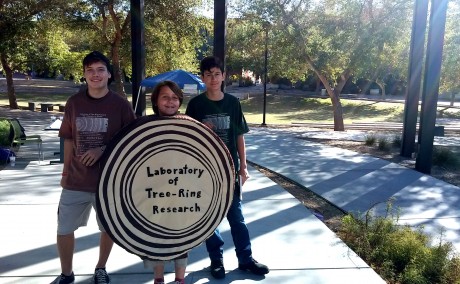The Open House will be on Saturday only; please note that the Arizona Daily Star's printed program for the Tucson Festival of Books is incorrect.
The date is March 14, and it runs from 9:30 in the morning to 4:30 in the afternoon. It will be at the Bryant Bannister Tree-Ring Building, 1215 E. Lowell Street, which is within easy walking distance to the south of the main Festival of Books booths on the University Mall, but not visible from there. Consult the map and directions if you have any difficulty finding it.
The Exhibit Hall will be open for visitors the entire time, and there will be booths immediately outside where you can earn more about dendroecology, dendroarchaeology, and dendroclimatology, with hands-on activities for all to explore.
Children of all ages will enjoy the woodland story telling area, with characters reading stories and face painting. Books will be raffled off throughout the day.
The “Meet the Scientist Talks” presentations will be in the Multipurpose Room (110) inside the building, each lasting for 20 minutes with a chance for discussion. The schedule is:
10AM: Dr. Dave Meko — “Tree rings and freshwater inflow to the Arctic Ocean”.
Abstract: Researchers at the Laboratory of Tree-Ring Research are collaborating with Russian scientists to study the long-term variability of flow of the Ob River, one the world's largest rivers and the source of almost ¼ of the total annual freshwater inflow to the Arctic Ocean. Freshwater inflow to the Arctic impacts sea-ice coverage and global climate. Highlights of the ongoing study and a summer 2014 field excursion are covered in the talk.
11AM: Dr. Ann Lynch — “Unstable times: frequency and severity of spruce beetle outbreaks on Mount Graham”.
Abstract: Bark beetle outbreaks have caused extensive and severe tree mortality in many western North American spruce-fir forests in recent decades, including one in the southern Arizonan Pinaleño Mountains that killed 85% of the trees. We are studying how frequently such events occur in southern Arizona, and how the forest recovers from such severe disturbances. Our results assist local forest managers' efforts to conserve and manage health and resiliency of the southernmost spruce-fir forest in North America.
1PM: Dr. Valerie Trouet — “Tree rings and shipwrecks: what past hurricane records can tell us about the future”.
Abstract: Assessing the impact of future climate change on North Atlantic tropical cyclone activity is of crucial societal importance, but the limited quantity and quality of the instrumental record interferes with the skill of future NATC projections. In particular, NATC response to radiative forcing is poorly understood and creates the dominant source of uncertainty for 21st century NATC projections. Here, we merge two annual-resolution proxies to study NATC variability during the Maunder Minimum (MM; 1645-1715 CE), a period defined by the most severe reduction in solar irradiance in documented history. We combine a documentary time series of Spanish shipwrecks in the Caribbean (1495–1825 CE) with a tree-growth suppression chronology from the Florida Keys (1707–2010 CE) and find a 74% reduction in NATC activity during the MM. Our results emphasize the need to enhance our understanding of the response of oceanic and atmospheric circulation patterns to future climate change in order to improve the skill of future NATC projections.
2PM: Dr. Charlotte Pearson — “Trade and Tree-Rings in the Lost Harbor of Constantinople”.
Abstract: Take a tour of a harbor dating to the first millennium AD in Turkey, and learn how LTRR researchers are using tree-rings in diverse ways to understand more about this remarkable site.
3PM: Chris Guiterman — “Distant and shifting sources for Chaco construction timbers”.
Abstract: The iconic great houses of Chaco Canyon stand as monuments to an ancient civilization that thrived in the middle of treeless landscape. Despite over a century of archaeological research, uncertainty remains regarding the production of many essential items to Chaco culture, including the 240,000 trees used to build the great houses. I will present on the first use of tree-rings in Southwestern archaeology to decipher the origins and procurement patterns of construction beams for the great houses.
For more information about this event, contact Pamela Pelletier at pamela@email.arizona.edu or 520.621.0984.


